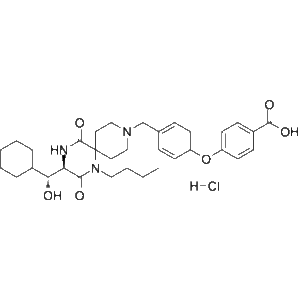Aplaviroc HCl
This product is for research use only, not for human use. We do not sell to patients.

For small sizes, please check our retail website as below: www.invivochem.com
| Size | Price | Stock |
|---|---|---|
| 100mg | $1950 | To Be Confirmed |
| 250mg | $2890 | To Be Confirmed |
| 500mg | $4333 | To Be Confirmed |
Cat #: V3645 CAS #: 461023-63-2 Purity ≥ 98%
Description: Aplaviroc HCl (GW873140A; ONO-4128; AK-602; GSK 873140) is the hydrochloride salt of Aplaviroc which is a SDP (spirodiketopiperazine) derivative, and a CCR5 entry inhibitor with anti-HIV activity.
Top Publications Citing Invivochem Products
Publications Citing InvivoChem Products
Product Promise

- Physicochemical and Storage Information
- Protocol
- Related Biological Data
- Stock Solution Preparation
- Quality Control Documentation
| Molecular Weight (MW) | 614.17 |
|---|---|
| Molecular Formula | C33H44ClN3O6 |
| CAS No. | 461023-63-2 |
| Storage | -20℃ for 3 years in powder formr |
| -80℃ for 2 years in solvent |
| Protocol | In Vitro | Aplaviroc exerts potent activity against three wild-type R5 HIV-1 strains (HIV-1Ba-L, HIV-1JRFL and HIV-1MOKW) with IC50 values of 0.1 to 0.4 nM. Aplaviroc is substantially more potent than two previously published CCR5 inhibitors, E921/TAK-779 and AK671/SCH-C. Aplaviroc suppresses the infectivity and replication of two HIV-1MDR variants, HIV-1MM and HIV-1JSL, at extremely low concentrations (IC50 values of 0.4 to 0.6 nM). Aplaviroc binds to CCR5 with high affinity. The Kd values thus determined for Aplaviroc, E913, E921/TAK-779, and AK671/SCH-C are 2.9±1.0, 111.7±3.5, 32.2±9.6, and 16.0±1.5 nM, respectively. Aplaviroc potently blocks rgp120/sCD4 binding to CCR5 with an IC50 value of 2.7 nM. These results suggest that the potent activity of Aplaviroc against R5 HIV-1 stems from its binding to ECL2B and/or its vicinity with high affinity, resulting in inhibition of gp120/CD4 binding to CCR5 |
|---|
These protocols are for reference only. InvivoChem does not
independently validate these methods.
| Solvent volume to be added | Mass (the weight of a compound) | |||
|---|---|---|---|---|
| Mother liquor concentration | 1mg | 5mg | 10mg | 20mg |
| 1mM | 1.6282 mL | 8.1411 mL | 16.2821 mL | 32.5643 mL |
| 5mM | 0.3256 mL | 1.6282 mL | 3.2564 mL | 6.5129 mL |
| 10mM | 0.1628 mL | 0.8141 mL | 1.6282 mL | 3.2564 mL |
| 20mM | 0.0814 mL | 0.4071 mL | 0.8141 mL | 1.6282 mL |
The molarity calculator equation
Mass(g) = Concentration(mol/L) × Volume(L) × Molecular Weight(g/mol)
Mass
=
Concentration
×
Volume
×
Molecular Weight*
The dilution calculator equation
Concentration(start)
×
Volume(start)
=
Concentration(final)
×
Volume(final)
This equation is commonly abbreviated as: C1 V1 = C2 V2
Concentration(start)
C1
×
Volume(start)
V1
=
Concentration(final)
C2
×
Volume(final)
V2
Step One: Enter information below
Dosage mg/kg
Average weight of animals g
Dosing volume per animal µL
Number of animals
Step Two: Enter the in vivo formulation
%DMSO
+
%
+
%Tween 80
+
%ddH2O
Calculation Results:
Working concentration:
mg/ml;
Method for preparing DMSO master liquid:
mg
drug pre-dissolved in
µL
DMSO(Master liquid concentration
mg/mL)
,Please contact us first if the concentration exceeds the DMSO solubility of the batch of drug.
Method for preparing in vivo formulation:
Take
µL
DMSO master liquid, next add
µL
PEG300, mix and clarify, next add
µL
Tween 80,mix and clarify, next add
µL
ddH2O,mix and clarify.
Note:
- (1) Please be sure that the solution is clear before the addition of next solvent. Dissolution methods like vortex, ultrasound or warming and heat may be used to aid dissolving.
- (2) Be sure to add the solvent(s) in order.




































